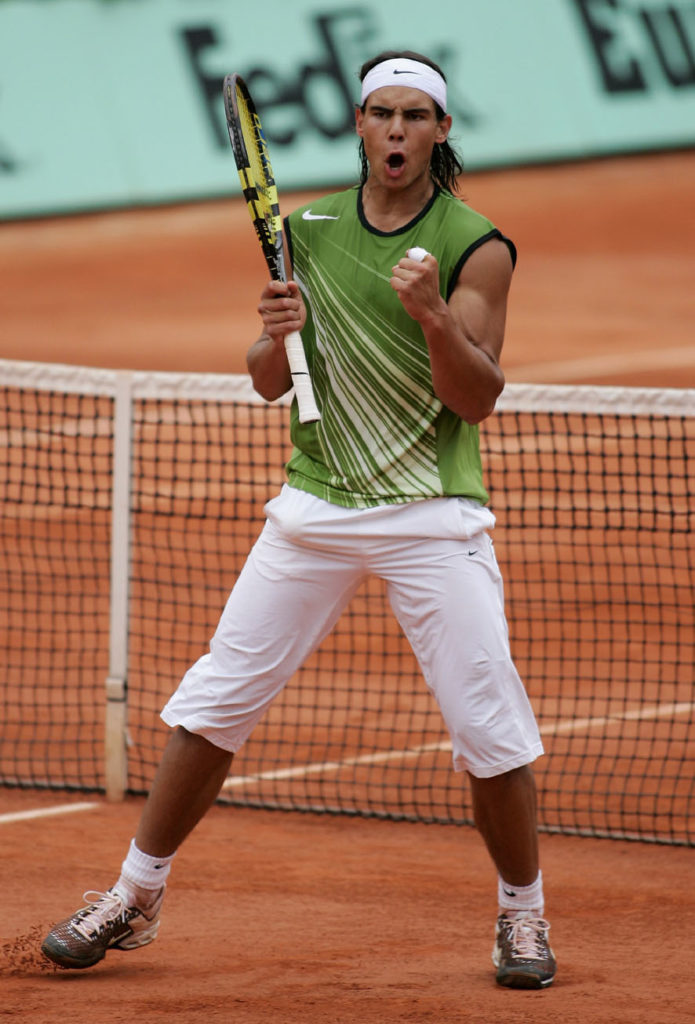Before Carlos Alcaraz, the last teenager to win a men’s major title was Rafael Nadal, also from Spain, when he won the French singles title in 2005. No one could document tennis history, and make you smile at the same time, quite like the late, great Bud Collins. The following is an excerpt from “The Bud Collins History of Tennis” book where Bud describes Nadal’s debut on the scene and his first major singles title just after his 19th birthday in Paris.
“Vamos, Rafa!”
That was the cry heard increasingly throughout the world as the big, fast and vivacious 19-year-old Spaniard Rafael Nadal came into view. Not just “promising,” which would be enough for most at that age – but as a major champion.
It’s thrilling as tennis evolves to watch a kid burst onto the scene and make an historic mark. Think of Billie Jean King at the 1961 Wimbledon doubles, Chris Evert at the 1971 U.S. Open, Evonne Goolagong at 1971 Wimbledon, Jimmy Connors at the 1973 U.S. Pro, Bjorn Borg at the 1974 French, Tracy Austin at the 1977 U.S. Open, Martina Navratilova at 1978 Wimbledon, Boris Becker at 1985 Wimbledon, Steffi Graf at the 1986 U.S. Open, Arantxa Sanchez Vicario and Michael Chang at the 1989 French, the Sisters Williams at the U.S. Open – Venus in 1997, Serena in 1999 – Martina Hingis at the 1997 Australian.
And Mats Wilander, 17, at the 1982 French, winning it on the first visit. It was Nadal who made such a move in 2005, champion as a novitiate. Only he and the Swede, Mats won at Roland Garros in their first attempt. In fact, Rafa, as 2008 dawned, remained undefeated in Paris, overpowering Argentine Puerta in 2005, then none other than Roger Federer in 2006-07.
After a round of 16 showing at the Australian Open, losing to eventual finalist Lleyton Hewitt in a titantic struggle 7-5, 3-6, 1-6, 7-6 (7-3), 6-2, Nadal took clay titles at Costa Do Sauipe, Brazil, 6-0, 6-7 (2-7), 6-1, over Spain’s Alberto Martin, and Acapulco, Mexico, 6-1, 6-0, over another Spaniard Albert Montanes, and made an impressive hard-court gallop to the final of Key Biscayne, simmering down against Federer in the final, 2-6, 6-7 (4-7), 7-6 (7-5), 6-3, 6-1.
Back to the comfort of clay, Rafa hiccupped in a quarterfinal loss to Russia’s Igor Andreev in Valencia, 7-5, 6-2, but would not lose another match on the dirt for another 25 months. He won Monte Carlo, beating Guillermo Coria, 6-3, 6-1, 0-6, 7-5, then Barcelona, taking out Juan Carlos Ferrero 6-1, 7-6 (7-4), 6-3 and then in Rome in an epic Italian final over Coria, 6-4, 3-6, 6-3, 4-6, 7-6 (8-6). The excellently fought five hour and 14 minute job was the longest ever final at Il Foro Italico, and the match of the year, as Nadal rose from 0-3 in the fifth, watched Coria blunt three match points in the tie-breaker before missing a backhand. Called “El Mago” (magician) by his admirers, Coria made himself disappear with the concluding error.
At the French, Nadal surrendered sets to Sebastien Grosjean (6-4, 3-6, 6-0, 6-3 in the round of 16), and to Federer (6-3, 4-6, 6-4, 6-3 in the semifinals) before hanging on to take out the difficult unseeded upstart, No. 37 Puerta, 6-7 (6-8), 6-3, 6-1, 7-5, in the rare all-lefty final. Nadal was the seventh Spaniard to win the men’s prize at Roland Garros and one of five teen-age champs. In December, it was announced that Puerta failed a drug test after the French final – testing positive for the stimulant etilefrine. Puerta was forced to return his prize money, was stripped of his points and suspended eight months (later shortened to two years on appeal).
Had drugs helped his endurance? Some thought so, considering his long battles in the quarters and semis: over Argentine Willy Canas, 6-2, 3-6, 1-6, 6-3, 6-4, and over Russian Nikolay Davydenko, 6-3, 5-7, 2-6, 6-4, 6-4, but a three-person panel concluded that Puerta mistakenly ingested the drug will drinking out of his wife’s wine glass.
Gaston Gaudio labored hard to keep his French title, but another Spaniard, David Ferrer, unseated him in the fourth round, 2-6, 6-4, 7-6 (7-5), 5-7, 6-4.
Nadal finished the year with 11 titles – tied with Federer for tops for the year – a 70-15 won-loss record, but was a solid No. 2 behind Federer, who won Wimbledon for a third straight year and the U.S. Open for a second time.

